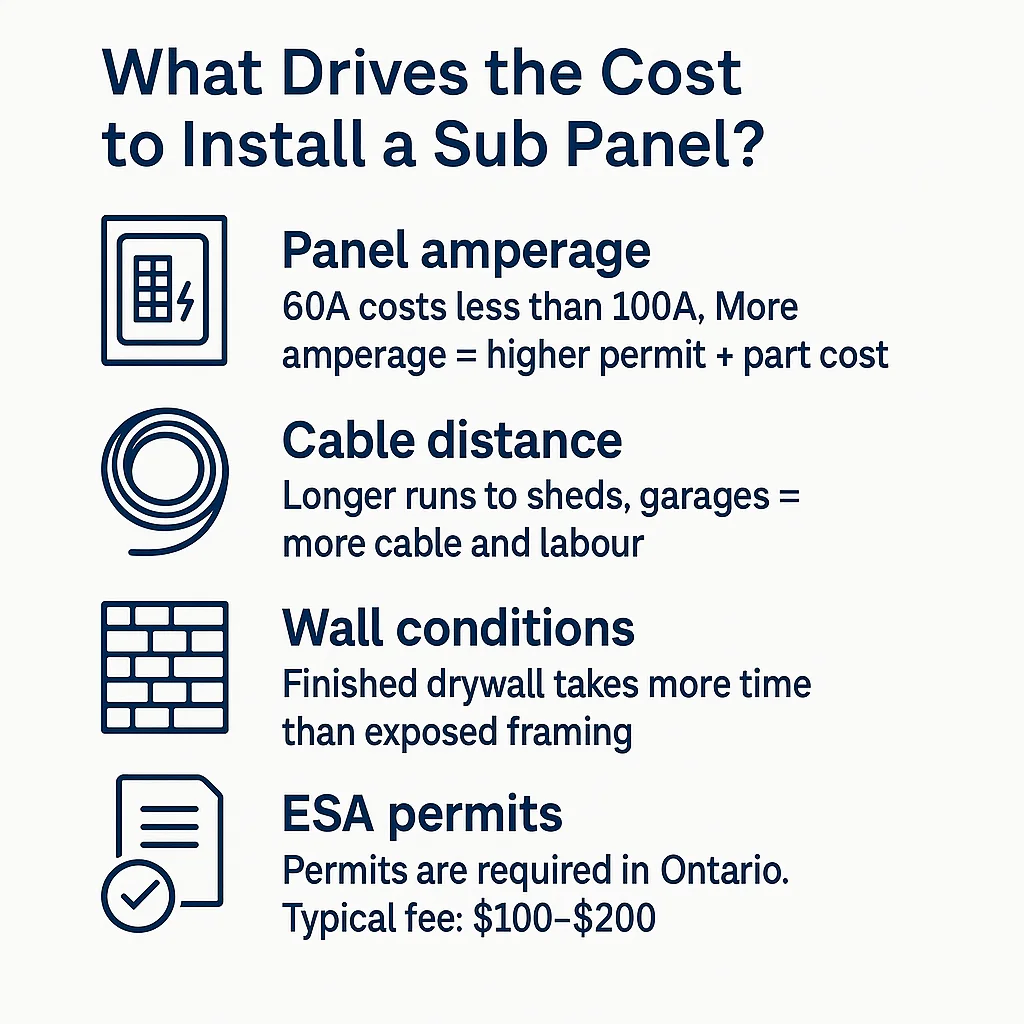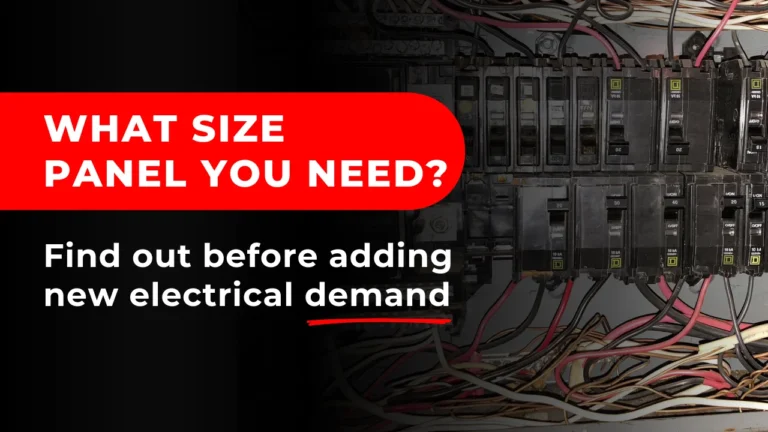If you’re planning a renovation, setting up a home office, or adding an EV charger, you might find your current electrical panel doesn’t quite cut it. In many cases, a sub panel can be a practical way to extend your system without overhauling the whole thing. But how much does it actually cost to install one? If you’re considering a home electrical panel upgrade, understanding the cost to install a sub panel is part of the bigger picture. More specifically, what’s the real cost to install a sub panel safely and up to code?
That’s a fair question and a complicated one. Sub panel pricing isn’t something you can look up like a thermostat. It depends on your setup, your needs, and what your existing panel can handle. That said, you can get a solid understanding of what factors go into the cost to install a sub panel so you’re not blindsided when it’s time to book the job.
What affects the cost to install a sub panel?
The price to install a sub panel varies, but some common factors drive most of the cost:
- Panel size and amperage: A 60A panel will cost less than a 100A. Your needs depend on what you’re powering.
- Distance from the main panel: The farther the sub panel is from the main, the more cable and labour are involved.
- Location type: Installing in a finished basement is different from running wire to a detached garage or laneway unit.
- Permits and ESA inspection: All legal sub panel installs in Ontario require ESA notification. That adds fees, but also protects your home.
- Main panel readiness: If your main panel is full or outdated, some work may be needed before adding a sub panel.

A quick note on materials and labour
It’s easy to focus on the panel itself, but that’s often the least expensive part. Labour makes up the bulk of most installations. Add in conduit, cable, breakers, fasteners, and permit fees and suddenly the cost to install a sub panel adds up fast. That’s why licensed electricians don’t quote without seeing the space first.

Sub panel vs main panel cost: How it impacts your budget
Homeowners often ask if a sub panel is a cheaper alternative to a full panel upgrade. Sometimes it is. Sometimes it isn’t.
If your existing panel still has room and enough capacity, a sub panel can be a clean way to add circuits for a new basement suite or garage setup. But if your system is already maxed out, or if you’re adding high-demand appliances like a heat pump or Level 2 EV charger, you might need to upgrade the main panel first.

It helps to think of a sub panel as an extension cord with limits. It doesn’t increase your home’s electrical service, it really just redistributes it.
Curious about whether a sub panel is even an option? Our blog on adding a sub panel vs upgrading your main panel breaks down the decision more fully, especially if you’re unfamiliar with what goes into installing an electrical sub-panel.
Common homeowner misconceptions about sub panel installation pricing
In last year’s Ontario Electrical Safety Report by the ESA, they report that electrical distribution equipment, including wiring and panels, was responsible for 423 residential fires in Ontario in 2022 alone.
This kind of stat makes it clear: cutting corners on compliance or DIY shortcuts is risky, and it’s proven to cause real damage.

We hear a lot of assumptions around sub panel installs. A few of the more common ones that we hear from homeowners are:
- “It should be cheap because it’s a small panel.” Not necessarily. The panel is only part of the cost. Labour, permits, materials, and inspection matter more.
- “My neighbour paid less.” Their install might’ve been closer to the main panel, or in an unfinished space. Every job is different.
- “I don’t need a permit.” In Ontario, ESA notification is mandatory. Skipping this could void insurance or cause problems when selling. Plus, we don’t go there.
- “My cousin can wire it because he knows a bit.” Unless your cousin is a Licensed Electrical Contractor with ESA credentials, that decision could be costly.
What we see locally (and what it means for the cost to install a sub panel)
In Hamilton and the surrounding area, we see a lot of sub panel installs triggered by these scenarios. Whether you’re in Waterdown, Stoney Creek, or downtown Hamilton, working with a certified and trusted Hamilton electrician means your install doesn’t come with any red flags or “oh no’s”:
- Finished basement renos: These often need new circuits for lighting, plugs, or in-law suites. If your main panel is full, a subpanel makes sense.
- Detached garages or workshops: Distance drives up labour and conduit costs. Trenching may also be required.
- Older homes: If your main panel is outdated or improperly wired, it may need to be addressed before installing a subpanel.
Here’s a rough idea of how various factors can influence pricing:
| Factor | Potential Impact |
| Distance to main panel | +$300–$1,000 depending on cable run |
| Panel amperage | 60A typically costs less than 100A |
| Permit & ESA inspection | +$100–$200 (mandatory) |
| Additional panel upgrades | Varies by condition and code compliance |
These are ballpark figures to illustrate complexity and not a real quote. The only way to get a firm number is through an on-site assessment. Still wondering how much does it cost to add a sub panel? It comes down to two things: what your panel can handle and what you plan to throw at it.
What to do next if you’re unsure about the cost to install a sub panel
The Real Estate Council of Ontario (RECO) reports that failing to obtain an ESA Certificate of Acceptance can negatively affect insurance claims and complicate resale transactions.
That’s why doing things by the book, permits, paperwork, and all, isn’t optional. It’s what protects you and your family.

If you’re looking into this type of upgrade, the smartest move is to book a panel inspection. A licensed electrician can check capacity, walk you through your goals, and determine whether a sub panel is the right fit.
You don’t need to have all the answers upfront. Just knowing your options is a strong place to start. We’ll help you figure out what makes the most sense for your home and your budget. That’s why we walk clients through cost factors for sub-panel installation before the first wire is even run.
A real example from a recent sub panel job
We recently worked with a family that was looking for a Dundas electrician to finish their basement. They needed new circuits for a small kitchenette, added lighting, and an electric fireplace. Their main panel was full but still had the capacity to support a subpanel. We ran a 60A sub panel from the existing service, passed ESA inspection, and left the space ready for the next phase of their reno. The job was clean, code-tight, and turned around in just under a day.
It’s a great example of how the right solution doesn’t always mean starting from scratch. It just means knowing what’s possible and doing it properly.
Ready to talk through your options?
We don’t guess when it comes to electrical. We only perform qualified installs that pass ESA inspection. If you’re planning a reno, setting up a workshop, or just running out of room in your main panel, we’ll walk you through your options.
Frequently asked questions about the cost to install a sub panel
What’s the typical cost for sub panel installation in Ontario?
Most installs land between $800 and $2,000+. The exact cost depends on amperage, how far the sub panel is from the main panel, and whether any panel upgrades or permits are required.
Is it cheaper to install a sub panel than upgrade the main panel?
Often, yes. If your existing panel still has capacity. But if your service is already maxed out, a main panel upgrade might be the only safe (and legal) option.
What can increase the cost to install a sub panel?
Long cable runs, finished spaces that require careful routing, trenching to outbuildings, and any code corrections to your main panel can all increase cost.
Is the ESA inspection included in the install cost?
Licensed contractors usually handle this as part of the job. The permit fee itself is typically $100–$200 and should always be included in your quote.
How long does it take to install a sub panel?
Most residential installs are completed in a single day, but complex layouts or older wiring conditions can add time. Depending on the amount of work, the cost to install a sub panel will differ.




